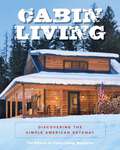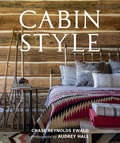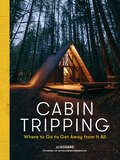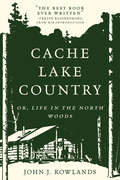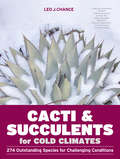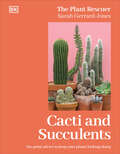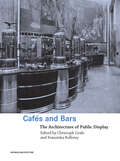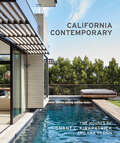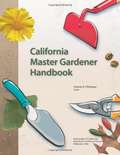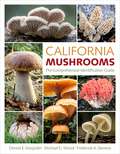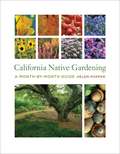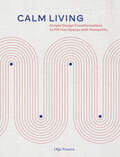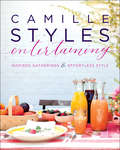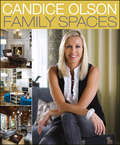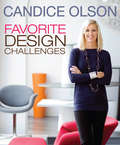- Table View
- List View
Cabin Living: Discovering the Simple American Getaway
by The Editors of Cabin Living MagazineA tour through America&’s favorite cabins Created in partnership with Cabin Living magazine.An inspirational celebration of one of America&’s icons. Handsomely designed with more than 300 color photographs. Cabin Living is a collection of twenty-five of the best stories covering legacy cabins, dream cabins, as well as tiny cabins from across the United States. In addition, floor plans, hundreds of full-color photos, maintenance and decorating sidebars, outdoor living and recreation features, and anecdotes about family gatherings, traditions, all give expert advice about how to achieve the cabin state-of-mind.Cabin Living magazine provides stories and expert advice about cabin maintenance, decorating, DIY projects, remodeling, outdoor living and recreation, hosting and more.
Cabin Porn: Inside
by Freda MoonLearn to make your own quiet place somewhere with this inspiring journey inside tranquil cabins and handmade homes, from the creators of the wildly popular Cabin Porn phenomenon. Cabin Porn began as an online project created by a group of friends to inspire their own homebuilding. It has grown into a global phenomenon, attracting thousands of submissions from fellow cabin builders and a passionate audience of millions interested in simple, efficient homes and the beauty of nature.Cabin Porn: Inside invites readers into these handmade homes to discover rooms of warmth and simplicity, connected by the universal desire to bring a simple building to life in harmony with the land around it. Each of these tranquil getaways is a lesson in living simply and joyfully.Here you will find hundreds of examples of what makes a cabin: the small details that enable their dwellers to live pleasantly and sustainably, as well as the mistakes and adaptations that reveal what builders must learn while creating their own homes. Perhaps most touching is the evidence that these homes have hosted charming and memorable evenings for the people who worked together to build them. Full of spellbinding spaces of warmth and ingenious simplicity, Cabin Porn: Inside is an invitation to the cabin of your dreams and to the serenity of a simpler life.
Cabin Porn: Inspiration for Your Quiet Place Somewhere
by Zach Klein Steven Leckart Noah KalinaRural escapes for those yearning for a simpler existence, by the creators of the wildly popular tumblr Cabin Porn.Created by a group of friends who preserve 55 acres of hidden forest in Upstate New York-Cabin Porn began as a scrapbook to collect inspiration for their building projects. As the collection grew, the site attracted a following, which is now a huge and obsessive audience.The site features photos of the most remarkable handmade homes in the backcountry of America and all over the world. It has had over 10 million unique visitors, with 350,000 followers on Tumblr. Now Zach Klein, the creator of the site (and a co-founder of Vimeo) goes further into the most alluring images from the site and new getaways, including more interior photography and how-to advice for setting up a quiet place somewhere. With their idyllic settings, unique architecture and cozy interiors, the Cabin Porn photographs, are an invitation to slow down, take a deep breath, and feel the beauty and serenity that nature and simple construction can create.y that nature and simple construction can create.
Cabin Style
by Chase Reynolds EwaldThe co-authors of American Rustic share inspirations for rustic elegance in home design for those who love living well in wild places. This gorgeously photographed volume offers visions of refined cabin style by top designers, builders, architects, and artists. From Napa to Nashville and along the Rocky Mountain spine, each project reflects the ways we live, and play, in nature. Whether a bison ranch, a log fishing cabin, a stone guest house, a lakeside retreat, a ski chalet, or a wine country barn, each home exhibits whimsical, playful, comfortable, and welcoming interiors and architecture—always inspired by the land. The homes curated in Cabin Style represent a fresh look at the genre, from traditional to transitional to modern. Interviews with architects, designers, builders and owners illuminate both the backstory and the creative process. Photographer Audrey Hall and writer Chase Reynolds Ewald have collaborated on five books, with their book American Rustic being named one of Best Home Design Books of 2015 by Architectural Digest.
Cabin Tripping: Where to Go to Get Away from It All
by JJ EggersA mountain lodge 5,000 feet up in Washington State&’s Cascades mountains, accessible only by skis—or an SUV tricked out with bulldozer-size snow tires. A sleek cabin just 80 minutes from Manhattan, overlooking the property&’s pond and 19 acres of woodland. A romantic, eco-friendly escape in the misty mountains of Bali&’s Gunung Agung volcano. A glass-domed Finnish hut offering unobstructed views of the Northern Lights. Whether readers are seeking a once-in-a-lifetime adventure or a quiet retreat, a cozy night around a firepit or a summery lakefront sojourn, Cabin Tripping delivers. Divided into six chapters—Forest, Tropics, Mountain, Arctic, Water, and Desert—the book features a curated collection of over 80 of the most incredible cabins available to rent all over the globe. Each cabin profile includes information on how to get there, activities to enjoy in the area (hiking trails, fishing holes, thermal spas, and more), and tips like when to plan your visit to maximize your &“leaf-peeping&” or whale-watching opportunities.
Cabinetmaking and Millwork (5th Edition)
by John L. FeirerA textbook for advanced woodworking students and also for anyone interested in the fundamentals of materials, tools, machines, and processes used in the building of cabinets and interiors, the production of furniture, and the other work of the finish carpenter, cabinetmaker, and millwright. The book can be used effectively in the upper levels of the senior high school, in vocational and technical schools, and in colleges.
Cache Lake Country: Or, Life in the North Woods
by John J. RowlandsThe classic chronicle of life and self-reliance in the great Northern Forest, reissued for its many fans “Cache Lake Country is a gem for many reasons—a simple narrative, the ways in which it conveys the work-a-day joys and exertions of life in the wilderness, the woodscraft techniques it illustrates, and the slow and pleasurable way in which the soul of a serene man is revealed.” —The New York Times Over half a century ago, John Rowlands set out by canoe into the wilds of Canada to survey land for a timber company. After paddling alone for several days, he came upon "the lake of my boyhood dreams," which he named Cache Lake because there was stored the best that the north had to offer?timber for a cabin; fish, game, and berries to live on; and the peace and contentment he felt he could not live without. This is his story, containing both folklore and philosophy, with wisdom about the woods and the demand therein for inventiveness. It includes directions for making moccasins, stoves, shelters, outdoor ovens, canoes, and hundreds of other ingenious and useful gadgets.
Cacti and Succulents for Cold Climates: 274 Outstanding Species for Challenging Conditions
by Leo J. ChanceThere are many reasons to grow cacti and other succulents—they're drought-tolerant, low-maintenance, and they look great. But what about hardiness? For those who thought that these spectacular plants were only for gardens in California and the Southwest, guess again—hundreds are fully cold-hardy and can be grown outdoors from New England to British Columbia, Wisconsin to Texas. Cacti and Succulents for Cold Climates is filled with inspirational portraits of 274 plants that can be used to create drought-tolerant gardens, as well as tips from regional experts who have mastered the art of growing cacti in parts of the country not usually associated with high temperatures or a scarcity of water. Expert Leo Chance describes how to prepare planting beds, how to get plants well established, how to handle cacti during planting, how to protect plants from cold winters, and when and how much to water.
Cacti and Succulents: On-point Advice to Keep Your Plants Looking Sharp
by Sarah Gerrard-JonesStep into the fascinating world of succulents and cacti.Sarah Gerrard-Jones (@theplantrescuer) makes understanding, growing, and enjoying cacti and succulents simple. From learning about mature plants in their native habitats to showing you how to revive flagging cacti or propagating plants on your windowsill, this beautifully photographed guide has something to share with beginners and experienced enthusiasts alike.Learn how to create the best conditions for your plants to thrive indoors or out, discover new varieties to grow, and try planting projects to take your collection to the next level. Sarah’s engaging and passionate writing shares all her personal experience to ensure anyone can love looking after their cacti and succulents.
Cafes and Bars: The Architecture of Public Display (Interior Architecture)
by Franziska Bollerey Christoph GrafeThe design of bars and cafes has played an important role in the development of architecture in the twentieth century. This influence has been felt particularly strongly over the past thirty years, in a time when these social spaces have contributed significantly to the rediscovery and reinvention of cities across Europe and North America. This volume presents and examines this significant urban architectural production, and discusses it against a background of the design of cafes and bars across the nineteenth and twentieth centuries. Major themes and developments are discussed and illustrated with case studies, from the functionalist pre-World War Two architects in Central Europe representing modern society through the design of public spaces, right up to the design of sophisticated bars and cafes as part of the recent urban renaissance of Barcelona and Paris in 1980s and London in the '90s.
California Contemporary: The Houses of Grant C. Kirkpatrick and KAA Design
by Grant KirkpatrickThe stunning houses of Grant Kirkpatrick and his firm, KAA Design, exemplify why so many of us look to Southern California as the pinnacle of sophisticated modern living. Two dozen magnificent custom homes,modern in style, are built of sensuous materials and sited to make the most of nature, views, and sunlight. This collection of visionary residences, shown in gorgeous photographs and colorful drawings, represents the California Dream, by an architect chosen by celebrities including TomHanks and Rita Wilson, Matt Damon, and Julia Louis-Dreyfus, for their personal retreats. Kirkpatrick offers his reflections on these beautiful projectsand the design strategies behind their creation.
California Master Gardener Handbook
by Dennis R. PittengerThe California Master Gardener Handbook is a resource manual useful for Master Gardeners throughout the state. It serves as a reference tool after the formal Master Gardening training program. It is particularly designed to provide participants with extensive knowledge on horticulture and other related UCCE disciplines.
California Mission Landscapes: Race, Memory, and the Politics of Heritage (Architecture, Landscape and Amer Culture)
by Elizabeth Kryder-Reid&“Nothing defines California and our nation&’s heritage as significantly or emotionally,&” says the California Mission Foundation, &“as do the twenty-one missions that were founded along the coast from San Diego to Sonoma.&” Indeed, the missions collectively represent the state&’s most iconic tourist destinations and are touchstones for interpreting its history. Elementary school students today still make model missions evoking the romanticized versions of the 1930s. Does it occur to them or to the tourists that the missions have a dark history? California Mission Landscapes is an unprecedented and fascinating history of California mission landscapes from colonial outposts to their reinvention as heritage sites through the late nineteenth and twentieth centuries. Illuminating the deeply political nature of this transformation, Elizabeth Kryder-Reid argues that the designed landscapes have long recast the missions from sites of colonial oppression to aestheticized and nostalgia-drenched monasteries. She investigates how such landscapes have been appropriated in social and political power struggles, particularly in the perpetuation of social inequalities across boundaries of gender, race, class, ethnicity, and religion. California Mission Landscapes demonstrates how the gardens planted in mission courtyards over the past 150 years are not merely anachronistic but have become potent ideological spaces. The transformation of these sites of conquest into physical and metaphoric gardens has reinforced the marginalization of indigenous agency and diminished the contemporary consequences of colonialism. And yet, importantly, this book also points to the potential to create very different visitor experiences than these landscapes currently do.Despite the wealth of scholarship on California history, until now no book has explored the mission landscapes as an avenue into understanding the politics of the past, tracing the continuum between the Spanish colonial period, emerging American nationalism, and the contemporary heritage industry.
California Mushrooms: The Comprehensive Identification Guide
by Michael G. Wood Dennis E. Desjardin Frederick A. StevensWinner of the CBHL Award of Excellence California is one of the most ecologically rich and diverse regions of North America, and home to hundreds of species of mushrooms. In California Mushrooms, mycologist experts Dennis Desjardin, Michael Wood, and Fred Stevens provide over 1100 species profiles, including comprehensive descriptions and spectacular photographs. Each profile includes information on macro- and micromorphology, habitat, edibility, and comparisons with closely related species and potential look-alikes. Although the focus of the book is on mushrooms of California, over 90% of the species treated occur elsewhere, making the book useful throughout western North America. This complete reference covers everything necessary for the mushroom hunter to accurately identify over 650 species.
California Native Gardening
by Helen PopperThis is the first month-by-month guide to gardening with native plants in a state that follows a unique, nontraditional seasonal rhythm. Beginning in October, when much of California leaves the dry season behind and prepares for its own green "spring," Helen Popper provides detailed, calendar-based information for both beginning and experienced native gardeners. Each month's chapter lists gardening tasks, including repeated tasks and those specific to each season. Popper offers planting and design ideas, and explains core gardening techniques such as pruning, mulching and propagating. She tells how to use native plants in traditional garden styles, including Japanese, herb, and formal gardens, and recommends places for viewing natives. An essential year-round companion, this beautifully written and illustrated book nurtures the twin delights of seeing wild plants in the garden and garden plants in the wild.
California Tenants' Rights (16th edition)
by Janet Portman David BrownCalifornia renters will find up-to-date information on their legal rights and ways to pursue them in this guide by attorneys Portman and Brown. After an overview of general considerations, chapters address issues in: looking for and renting a place, sharing a home, rent, discrimination, right to privacy from landlords, repairs and maintenance, alterations and satellite dishes, injuries and crime on the premises, environmental hazards, breaking a lease and subleasing, security deposits and last month's rent, evictions, tenant organizing, renter's insurance, and condominium conversion. The appendix contains forms to use while renting, while fighting an eviction, or after losing a fight against an eviction. Advice includes conditions under which legal help is advised. All information is specific to California law. Annotation ©2007 Book News, Inc., Portland, OR (booknews.com)
Call It Home: The Details That Matter
by Amber LewisThrough gorgeous photography and heartfelt essays, the interior designer and author of Made for Living reveals her detail-oriented approach to renovating, decorating, and building a beautiful home.The details can make a room. The bullnose edge of a marble countertop. The wood grain and color of the flooring. The particular pleat of the drape. Amber Lewis, the esteemed designer known for her signature California-inspired style, obsesses over the tiniest of features to create her eclectic, laid-back look. In Call It Home, she shares her secrets to choosing and applying fabric, paint, finishes, tile, flooring, and more for a beautifully designed home, shortcutting the often-overwhelming decision-making process. Amber walks you through eight new homes she designed—including her own—and the thought processes behind every major choice. Whether you're decorating one room, renovating your entire house, or planning new construction, she shares how to approach a project from start to finish, guiding you on how to find the right team so you can get the perfect results. Then she takes you through mountain retreats and surfside homes, dreamy escapes she&’s created by pulling inspiration from the surrounding property for a look that&’s unique to each home. Through personal essays, you&’ll learn how she set about the project, what challenges her team faced, and the materials she used to achieve the finished result.With more than 200 gorgeous images of livings rooms, kitchens, dining rooms, entryways, bedrooms, and baths, you'll have photographs of Amber's details on hand when you're ready to create your own collection of stunning spaces—and call it home.
Calm Living: Simple Design Transformations to Fill Your Spaces with Tranquility
by Olga TrusovaDiscover how simple changes can make any room—and its inhabitants—feel more inspired, clear, and energetic. Designer and Stanford instructor Olga Trusova's practical and inspiring guide offers easy-to-follow tips for cultivating a calming environment at home or at work.Using the principles of design thinking, Trusova distills essential design wisdom, revealing how to use light, color, sound, furniture, and more to make simple, intentional changes for a profound impact on your mind, body, and spirit. Illuminating examples, accessible tips, and short exercises reveal how easy it is to transform a space, whether you're targeting a small corner or multiple rooms. Brimming with smart, digestible design tips and life-changing techniques, this stylish handbook makes a lovely self-purchase or gift for creatives, design enthusiasts, at-home workers, and anyone looking for simple, proven ways to design a soothing space.
Camille Styles Entertaining
by Camille StylesCelebrate The EverydayInfused with the youthful spirit of popular lifestyle blogger and event stylist Camille Styles, this lush how-to for entertaining features fresh, inspirational party ideas for every season. Camille Styles Entertaining is your guide--brimming with creative hors d'oeuvres and cocktail recipes, floral design tips, and inspiring table designs--to the simple details and creative shortcuts that make everyday moments feel special. Thoughout, Camille shares inspiration from her own gatherings with friends and family, from an at-home pizza grilling night to a colorful fiesta dinner party.Filled with dozens of delicious recipes, approachable DIY projects, and tried-and-true tips for staying stress-free, this beautiful book will inspire you to celebrate everyday moments in a fun, natural, and creative way. helps you celebrate major holidays, milestones, and even everyday moments in a fun, stylish, and creative way.Each gathering featured in this gorgeously designed and photographed entertaining guide draws inspiration from up-and-coming trends and Camille's own experiences. In addition to creative hors d'oeuvres and cocktail ideas, floral design tips and inspiring table designs, here are parties for: Fall Celebrations: Picnic at the Farm, Thanksgiving Dinner Winter Celebrations: At-Home Game Night, Holiday Cookie Swap Spring Celebrations: Springtime Brunch, Fiesta Dinner Party Summer Celebrations: Mediterranean Anniversary Dinner, Grilled Pizza PartyWith Camille Styles Entertaining, you can transform a "normal" day into a fun gathering, engage the senses with beauty, and create unforgettable memories with family and friends.
Campbell's 1-2-3 dinner
by Publications International Ltd.Most recipes involve three easy steps and make four servings. Flash Roasted Crispy Ranch Chicken--oh, so good! Polynesian Pork Chops--mmmm! Buffalo-Style Burgers--I think you are getting the picture: just reading this book will make you hungry. And, teens, when it is your turn to cook, you can't go wrong with the recipes and serving suggestions in this book.
Can It & Ferment It: More Than 75 Satisfying Small-Batch Canning and Fermentation Recipes for the Whole Year
by Stephanie ThurowWelcome to the world of produce preservation. In Can It & Ferment It, blogger and preservation enthusiast Stephanie Thurow brings the canning and fermenting communities together by offering recipes that work for both canning and fermenting. From a first-timer to the advanced preservationist, Can It & Ferment It shows canners and fermenters alike how they can have the best of both worlds.Stephanie explains the differences between the canning and fermentation processes, emphasizes the importance of using local and organic produce, describes canning and fermenting terminology and the supplies needed for both methods, and offers more than seventy-five fun and easy recipes for every season. Readers will learn how to preserve each fruit or vegetable in two different ways; each can be enjoyed water bath–canned or as a healthy, probiotic-rich ferment.Recipes in this helpful guide include strawberry chutney, the perfect garlic dill pickle, spring onion kimchi, cinnamon-honey apple butter, and more!
Can It, Bottle It, Smoke It: And Other Kitchen Projects [A Cookbook]
by Karen SolomonHave you ever wanted to . . . Bottle your own soda? Press your own tofu? Smoke your own cheese? Boil your own bagels? Ferment your own miso? Can your own tomatoes? Roast your own coffee? Can It, Bottle It, Smoke It walks you through a slew of satisfying culinary projects to stock your larder and shower your friends with artisan foods and drinks, kitchen staples, and utterly addictive snacks. Karen Solomon--veteran food writer, kitchen explorer, and author of Jam It, Pickle It, Cure It--brings forth a new collection of 75-plus recipes for condiments (Plum Catsup), cereals (Cornflakes), crunchy snacks (Tortilla Chips), beverages (Soy Milk), and more. Whether you're a beginning or seasoned home cook, you'll be inspired to pump up the power of your pantry. With detailed instruction on essential techniques, time commitments for each project (from 20 minutes to 2 hours to a weekend), and labeling and wrapping tips, Can It, Bottle It, Smoke It will help you get creative in the kitchen. So leave the grocery aisle's mass-produced packaging and mystery ingredients behind and join the urban homesteading revolution as you whip up a bevy of jars, bottles, and bags full of outstanding hand-labeled eats.From the Hardcover edition.
Candice Olson Bedrooms (Candice Olson)
by Candice Olson<P> Popular TV star and designer Candice Olson shows you how to create your dream bedroom Written in her approachable and authoritative voice, Candice Olson Bedrooms features 25 stunning room makeovers, with gorgeous room sketches and design boards that show you how each design took shape. More than 200 full-color before-and-after photos provide a wealth of visual inspiration, while Candice's tips and insights into what makes each space work will give you practical knowledge for planning your own bedroom redo.Candice's media outreach is extensive: her TV shows Divine Design and Candice Tells All, both of which air on HGTV in the U.S. and on W Network in Canada, are incredibly popular. <P> Her first book, Candice Olson on Design, has sold over 210,00 copies; her second, Candice Olson Kitchens & Baths, sold over 72,000 copies in its first yearMost homeowners must work with the spaces they have, and redecorating a bedroom is typically far less expensive than redoing a kitchen or bathroom Candice's dreamy designs will inspire you to bring big style to your master suites and guest quarters alike through smart choices in color, texture, lighting, furnishings, accessories, and storage.
Candice Olson Family Spaces (Candice Olson)
by Candice Olson<P>Popular TV star Candice Olson shows you how to create your dream family room Everybody wants their home's main living space to meet the needs of the whole family—and look great doing it. HGTV star Candice Olson is an expert in showing clients how a room can have many functions while still looking pulled-together and polished, and this book showcases a collection of her family room redos that is sure to inspire. Chock full of tips and ideas, Candice Olson Family Spaces features hundreds of full-color, before-and-after photos of Candice's stunning family room makeovers. Plus, you'll get access to her artful room sketches and design boards and insight into how each design took shape, giving you unprecedented guidance for planning your own family room renovation. Explains how good design accommodates all members of the family and their daily activities. <P> Designs offer functionality, durability, and comfort without sacrificing style. As a busy mother of two, Candice brings valuable insight to what a family really needs from the spaces they share. Redecorating—or even just dreaming about decorating—can transform one's outlook on life, and Candice Olson Family Spaces is the catalyst to get readers off the couch and down to the upholstery store.
Candice Olson Favorite Design Challenges (Candice Olson)
by Candice Olson<P> Popular TV star Candice Olson shares her favorite design challenges. Candice Olson Favorite Design Challenges focuses on the tricky situations that Candice expertly handles for her clients—the same challenges that many homeowners face. From working around architectural limitations like sloped ceilings or a lack of wall space, merging styles to ensure that a room's decor pleases all of a home's occupants, to accommodating the changes that come about when a family grows or shrinks, this book highlights those ingenious solutions that make Candice's designs both beautiful and functional. <P> Featuring 25-30 of Candice's stunning room makeovers—described in her approachable and authoritative voice—Candice Olson Favorite Design Challenges provides gorgeous sketches and design boards that show you how each design took shape, while more than 200 full-color before-and-after photos offer a wealth of visual inspiration.Includes Candice's tips and insight into what makes each space work. <P> Candice shares how she overcame the predominant challenge in each case. Provides invaluable guidance on planning your own room redos. Redecorating—or even just dreaming about decorating—can transform one's outlook on life, and Candice Olson Favorite Design Challenges is just what you need to dream, plan, and execute up a redo in your own home.
